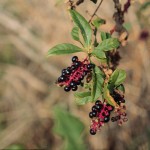Pokeberry, Pokeweed
Phytolacca americana
Phytolaccaceae
Description
Pokeberry is a smooth, shiny plant arising from a large perennial rootstock. Its stalks become purple-red with age and are usually 5 or 6 feet tall but may be as tall as 10 feet. The large leaves, up to 4 inches wide and 10 inches long, are entire (the edges have no notches or indentations) and alternate. The small white or pinkish flowers are arrayed in drooping spikes and give rise to juicy, purple-black berries.
Habitat
Pokeweed is found in the eastern two-thirds of Texas and is reported from Maine and Ontario to Florida and California. It usually grows in disturbed, sandy soils and is often found in bulldozed brush piles.
Toxic Agent
Saponins are concentrated in the rootstock and young leaves of pokeweed. All species of animals have been affected by consumption of the plant. Pigs uprooting the plants and consuming the rootstocks are the most likely to be poisoned. Young leaves are eaten by humans as greens, but the water must be changed during cooking to remove the toxins.
Signs of Livestock Ingestion
This plant is a gastrointestinal irritant, with clinical signs of poisoning occurring within a few hours of consumption: Abdominal pain; Vomiting; Diarrhea (sometimes with blood); Death.
Consumption of the leaves usually produces only a transient gastrointestinal disease in ruminants. Cattle often consume small amounts of mature leaves with no ill effects.
Management Strategies
Do not place pigs in a pen containing well-established plants with large rootstocks. Short pastures containing old brush piles with large amounts of pokeberry and little other forage should not be used for livestock.
Images
Plant Characteristics
Flower Color: White
Seed Type: Fruit/Berry
Duration: Annual
Stem Texture: Hairless/Smooth
Growth Habit: Forbs/Broadleaf
Leaf Shape
 : Simple with Pinnate or Parallel Venation
: Simple with Pinnate or Parallel Venation
Season: Warm
Distribution
 : 01 - Pineywoods, 02 - Gulf Prairies and Marshes, 03 - Post Oak Savannah, 04 - Blackland Prairies, 05 - Cross Timbers and Prairies, 06 - South Texas Plains, 07 - Edwards Plateau, 08 - Rolling Plains
: 01 - Pineywoods, 02 - Gulf Prairies and Marshes, 03 - Post Oak Savannah, 04 - Blackland Prairies, 05 - Cross Timbers and Prairies, 06 - South Texas Plains, 07 - Edwards Plateau, 08 - Rolling Plains
Distributions
Distribution refers to the ecological region in Texas that a plant has been found. You can also view a clickable map.
Book: Toxic Plants of Texas (B-6105)
Collection: Toxics
Livestock Affected: Cattle, Goats, Horses, Pigs, Sheep
Livestock Signs: Abdominal Pain, Colic, Diarrhea, Vomiting/Regurgitation





